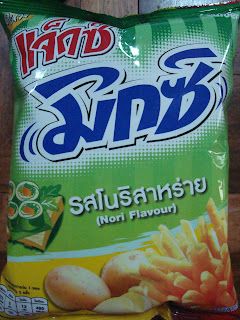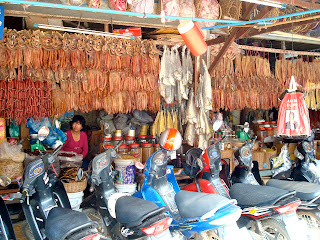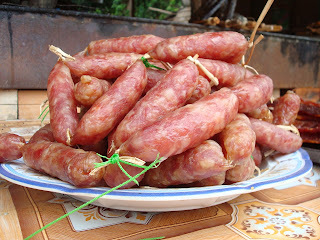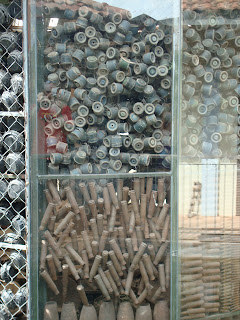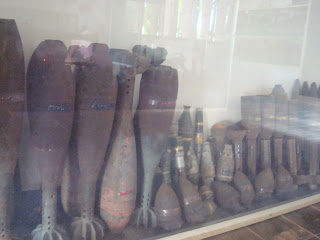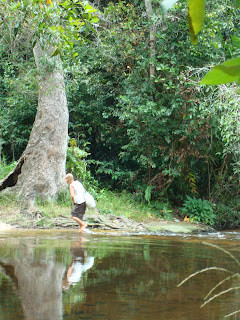If you're looking for a thrill ride, come to Siem Reap and drive a moto (or as I affectionately, or ignorantly, call them, scooters). Take a cruise around town for just five-ten minutes and obtain that edge-of-your-seat feeling. Every time, and I mean every time, I either ride in a tuk tuk or drive our scooter in town I think I am going to die or get injured at some point during the trip. I've done some dumb shit in my life, but driving a scooter where there are no discernable rules of the road means you risk serious injury every time you head out. The absolute lack of rational driving laws is beyond explanation, even for someone who barely earned a C in drivers ed twenty years ago. I'll try to explain what it is like to drive and own a scooter in Cambodia, please bear with me.
Every time we take the scooter out, something goes wrong. This is literal, or at least was for a good amount of time when we initially owned this red and white dream machine you can see below.
 |
| Our 2008 Yamaha Fino, 115cc automatic |
Neither of us, that's me and my wife, had ever driven or even ridden on a scooter before moving to Cambodia. After living here for a month or so we thought it would be "fun" to have our own scooter. You see them everywhere and they do not look difficult to operate. In hindsight, that was our first misstep, that simple misjudgment of driving. Without a test drive, we bought a used scooter and that was that. When I started it and began to head toward the nearest gas station, the scooter really took off as I had seriously misjudged the power of a 115cc engine. The people at the shop started yelling that I slow down and take it easy at first, it was obvious I had no clue what I was doing. The shop is on the busiest road in town and navigating the traffic was one of the most nerve-racking events of my life. Big trucks, tour buses, SUVs, sedans, other scooters and bicycles were everywhere - it felt like I'd never seen traffic before. After filling up the gas tank for $3USD, Kathy jumped on back and we headed home, slowly. With sweaty palms, we made it to the grocery store and home. This began our great scooter adventure.
Successful as we were on that initial drive, things didn't go so well after that. We go out for one of our first jaunts downtown to visit our favorite French sandwich shop and we wreck two blocks from our destination. Within the first week of pre-owner scooter ownership we add some glorious road rash to the flawless paint job. I was lucky and able to avoid serious injury, but my wife had the deceptively heavy scooter fall on her leg and she scrapped the hell out of her foot. Yes, I did, and still do, feel bad. Let me explain the scenario. When I was trying to turn right, which should not be an issue, I was confronted with a driving situation I had never faced before. I panicked when I saw a SUV heading toward me very closely on the left, multiple scooters/motos and tuk tuks also approaching also on the left but there were also more scooters cutting between me and the curb to
my right - what do I do? Well, I chose to slam on the breaks and then I cut the wheel too hard, so we subsequently fell over. (It was almost as much fun as picking up my wife on our second ever date. - haha)
One Saturday we take it on the eight kilometer ride to work. For this trip we must take a paved national road and then a red dirt road, 4km each. It was a pleasant morning and the blue sky was begging for us to take a ride. The trip to work was great. There was little traffic, because we work in a rural village, and we were making great time. We parked it at work and talked about how great the trip out was and how we'll do this more in the future. After work we eagerly jump back on the scooter and head down the bumpy dirt road toward our home. The engine sounded a bit odd, but what do I know about scooters. Once we are on the national road and we picked up some speed it breaks down, it simply stopped running. This situation provided a very unique experience.
As we were standing on the side of the road blankly looking at the scooter, a man on a much more reliable scooter, a Honda Dream, stopped to ask if we needed help. He spoke fluent English and told us he "was on the way home from worshipping" and thought we looked in need of assistance. I explained that the engine just stopped and that it would not start. He showed me how to use the kick starter, but it wouldn't work. When this failed he offered for me to drive his scooter and he'd hold on to the back of the seat and help tow it to a shop. I do not know how to shift on a scooter so that idea faded quickly. He then asked if I'd like to push it back to a "local" mechanic that is near the dirt road and see if he can fix it. I said yes, so he pushed his scooter next to me and we headed to the local mechanic. Since I do not speak Khmer, this guy translated for me and the mechanic started to work. Sadly, he could not fix it. As frustration set in, this stranger produced another great idea.
He headed toward town and convinced a tuk tuk driver to come out and load our scooter in his carriage and take it back to the shop where we purchased this pile of crap. After about ten minutes he was back and we were loading our scooter in the back of this tuk tuk. I never thought I'd be in a tuk tuk with a scooter inside. Once we finally arrived at the shop on the far side of town and unloaded the moto, this mysterious guy left following the tuk tuk back across town. We exchanged phone number and he would not take anything for his time, not even a beverage. When he rode off, it felt like he was some cowboy in a movie. It took over four hours to fix the scooter and I think they had to replace a major part. It is a bit louder now, but it does run.
When I say that it runs, I mean that it will eventually start and that it sometimes takes off when you don't want it to go. It takes a few tries to get it started. You turn the key and then press this button for it to turn over. Sometimes you press this button seven-eight times before it starts. Then you generally have to try to turn the accelerator four-five times, restarting it each time, before it really wants to go. It is quite a pain in the ass. You have to get to the scooter five-six minutes before you actually want to leave. After one of our little spills it now has the tendency to pull you forward when idling at a stop. You'll release the break and slowly start to move forward. It was scary at first but now it just makes it easier to get going again. I have developed quite the love-hate relationship with this scooter.
One afternoon we were driving down the dirt road in from of our apartment and my wife said her leg was getting wet. About this same time, I started smelling gas. We immediately stop and see that there is gas pouring out of the engine. Our thought was to try and make it back to the shop so we took off across town. Part of the way there it just stops. As we are stopped a few guys working as guards at a nearby hotel walk over to see what's the problem. They see the gas and start encouraging me to stop trying to start the scooter and they all step back. Even though we do not speak the same language, it was clear what they meant. My wife got in a tuk tuk and went to the shop where we got this god forsaken scooter. The mechanics followed her back and replaced the gas line right there on the side of the road. Again, it works now, but driving while leaking gas is not something I'd recommend to anyone.
We had a tire blow out while heading to breakfast one morning so we had to get it fixed. Since we were close to the restaurant Kathy said she'd walk and meet me there after I had the tire fixed. Driving a scooter with a flat tire sucks, trust me. As I tried to turn into the shop, the scooter fell on my leg and I completely fell on my ass and added more road rash to the red fenders. The guys from the tiny shop came out and helped me up and got the scooted in the shop. They fixed the tube very quickly and charged me 2000 riel, or $.50 in USD. After that the scooter has ridden much smoother.
Everyone I know who owns a scooter has two things in common, the speedometer and the odometer do not work. I've never seem anyone pulled over for speeding so I guess this is not an issue. As long as the gas gage works, who cares about the odometer, right?
Something else fun, if you're driving down a bumpy road, the key might fall out. The engine keeps running but the key is on your foot. This seems to be a common issue as I have observed many people connect the key to the handle bars for safety. When I take it to work, the key falls out repeatedly. At first I constantly felt the need to put it back, but then I finally realized that it does not matter and I now wait to replace it until I need to turn off the engine.
Rules of the road do not exist here. I cannot express myself properly when I say there is a serious need for even the most basic of rules here. As tourist season approaches in full force, the traffic becomes crazier and crazier. There are several stoplights at the major intersections, but until now only a few have actually functioned. I'll be curious if more are used as the traffic increases.
Here is a fun fact of reality. Headlights on scooters, not everybody uses them. The same applies to blinkers.
People do respect the horn, if it works.
Helmets are mandatory. Yes Illinois, helmets are mandatory in CAMBODIA!!! The fine for not wearing a helmet is, I believe, 5000 riel or $1.25 USD.
Do you need insurance? No.
What about a drivers license? Yes. No test is required, but they cost $35 USD and the fine for not having one is, again, I believe, 5000 riel. I have one because I want to try and rent a car in America with it next summer. It feels more like a novelty to have one.
Not long ago we saw a scooter hit our tuk tuk driver on his way to pick us up. Yes, it was quite the sight. I saw a man slide headfirst into on coming traffic and survive. How others avoided him, I'll never know. Our driver was hit in the leg and his carriage nearly turned over. Crazy. Needless to say, we had a different driver that night.
We've also seen two scooters collide. Out tuk tuk kept going and all I saw was two guys staring at each other - it's not like you're going to "trade info" and pray they don't sue. I do like the fact you don't hear people say "I'm going to sue you" here.
When driving in Siem Reap, size matters. The bigger the vehicle, the more of the road you can dominate. Tour buses dominate. SUV's and sedans blow their horns a lot and like to drive very close to tuk tuks. They are generally so close you can reach out and touch them. I want to start a series of pictures of me touching cars and buses while in traffic.
This post coud run forever.
For all of the aforementioned reasons, do not drive a scooter in Siem Reap.












